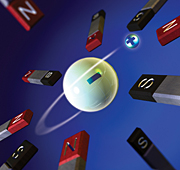- Number 327 |
- December 20, 2010
Atoms of antimatter trapped at CERN in Berkeley's magnetic bottle

Trapped-anti-H
Scientists from the DOE’s Lawrence Berkeley National Laboratory made key contributions to the international ALPHA Collaboration at CERN, which in November announced that it had trapped and stored atoms of antimatter for the first time – if only 38 of them (although that number has since increased rapidly), and for less than two seconds each.
Berkeley Lab’s efforts, led by Joel Fajans of the Accelerator and Fusion Research Division (AFRD), who is also a professor of physics at the University of California at Berkeley, included proposing, designing, and testing the octupole (eight-pole) magnet, fabricated at Brookhaven National Laboratory, that is the heart of the specially designed magnetic bottle used to capture the anti-atoms. Jonathan Wurtele of AFRD, also a professor of physics at UC Berkeley, led a team of Berkeley Lab staff members and visiting scientists who used computer simulations to verify the advantages of the octupole trap.
The atoms ALPHA stored were antihydrogen, consisting of a single negatively charged antiproton orbited by a single positively charged anti-electron (positron). While a few dozen anti-atoms are far from sufficient to fuel the Starship Enterprise (or threaten the Vatican), keeping anti-atoms from annihilating themselves as soon as they are made brings closer the day when they can be used to make precision tests of the fundamental symmetries of nature, revealing how the physics of antimatter differs from that of the ordinary matter that dominates the world we know today.
Large quantities of antihydrogen atoms were first made at CERN eight years ago by two other teams. They made antimatter but couldn’t store it, because the anti-atoms touched the walls of the experiments within millionths of a second and were instantly destroyed by conversion to energy and other particles.
“Trapping antihydrogen proved to be much more difficult than creating antihydrogen,” says Fajans. “ALPHA routinely makes thousands of antihydrogen atoms in a single second, but most are too ‘hot’” – too energetic – “to be held in the trap. We have to be lucky to catch one.”
An intricate arrangement of electric and magnetic fields within the Minimum Magnetic Field Trap was key to keeping the anti-atoms away from the walls of the trap to prevent them from annihilating. The trap’s unique superconducting octupole magnet, built to withstand repeated quenches within thousandths of a second, made it possible to capture, store, and release the anti-atoms on cue.[Paul Preuss, 510.486.6249,
paul_preuss@lbl.gov]
